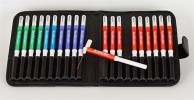Authors
T Silhol, M Chaouat, R Harizi, J Lambert, W Noel et al
Lab
Service de chirurgie plastique, esthŽtique et reconstructrice, H™pital Saint Louis, 1 avenue Claude Vellefaux, 75010 Paris, France.
Journal
Journal of Plastic, Reconstructive & Aesthetic Surgery
Abstract
Background Breast sensitivity is a significant issue in preoperative consultation prior to reduction mammoplasty. Although a range of techniques is used, recovery of sensation is usually evaluated using the inferior pedicle. Our objective was to evaluate and compare the change in breast sensitivity using the superomedial versus the superior pedicle.
Methods We performed a non-randomized, monocentric, prospective study. Thirty-six patients were examined by a single evaluator with von Frey monofilaments on the day prior to the surgery, at 3Ð6 months, and at 1 year postoperatively. The breast skin, areola, and nipple sensitivity were tested. The breasts were classified into two groups depending on whether the superior pedicle (S) or the superomedial pedicle (SM) technique was used.
Results The differences between the two groups indicate that the SM group had better sensitivity at 4.5 and 12 months postoperatively. The thresholds for the size filaments that could be felt at the first follow-up on the skin, the areola, and the nipple for the S group vs. the SM group were 2.55_vs. 2.41 (p_=_0.41), 4.57_vs. 4.45 (p_=_0.28), and 4.17_vs. 3.81 (p_=_0.04) size units, respectively. At 1 year postoperatively, the respective values were 2.62_vs. 2.52 (p_=_0.49), 4.28_vs. 4.05 (p_=_0.04), and 3.63_vs. 3.38 (p_=_0.10).
Conclusion The nerve fibers appear to be better preserved in the superomedial pedicle than in the superior pedicle. However, these differences were not clinically relevant. The choice of the technique should be made on the basis of the size and the shape of the breast, the patient morphology, and the operator's preference rather than being on the basis of the recovery of sensitivity.
BIOSEB Instruments Used:
Von Frey Filaments (Bio-VF-M)

 Pain - Thermal Allodynia / Hyperalgesia
Pain - Thermal Allodynia / Hyperalgesia Pain - Spontaneous Pain - Postural Deficit
Pain - Spontaneous Pain - Postural Deficit Pain - Mechanical Allodynia / Hyperalgesia
Pain - Mechanical Allodynia / Hyperalgesia Learning/Memory - Attention - Addiction
Learning/Memory - Attention - Addiction Physiology & Respiratory Research
Physiology & Respiratory Research
 Pain
Pain Central Nervous System (CNS)
Central Nervous System (CNS) Neurodegeneration
Neurodegeneration Sensory system
Sensory system Motor control
Motor control Mood Disorders
Mood Disorders Other disorders
Other disorders Muscular system
Muscular system Joints
Joints Metabolism
Metabolism Cross-disciplinary subjects
Cross-disciplinary subjects Happy new year 2025
Happy new year 2025 